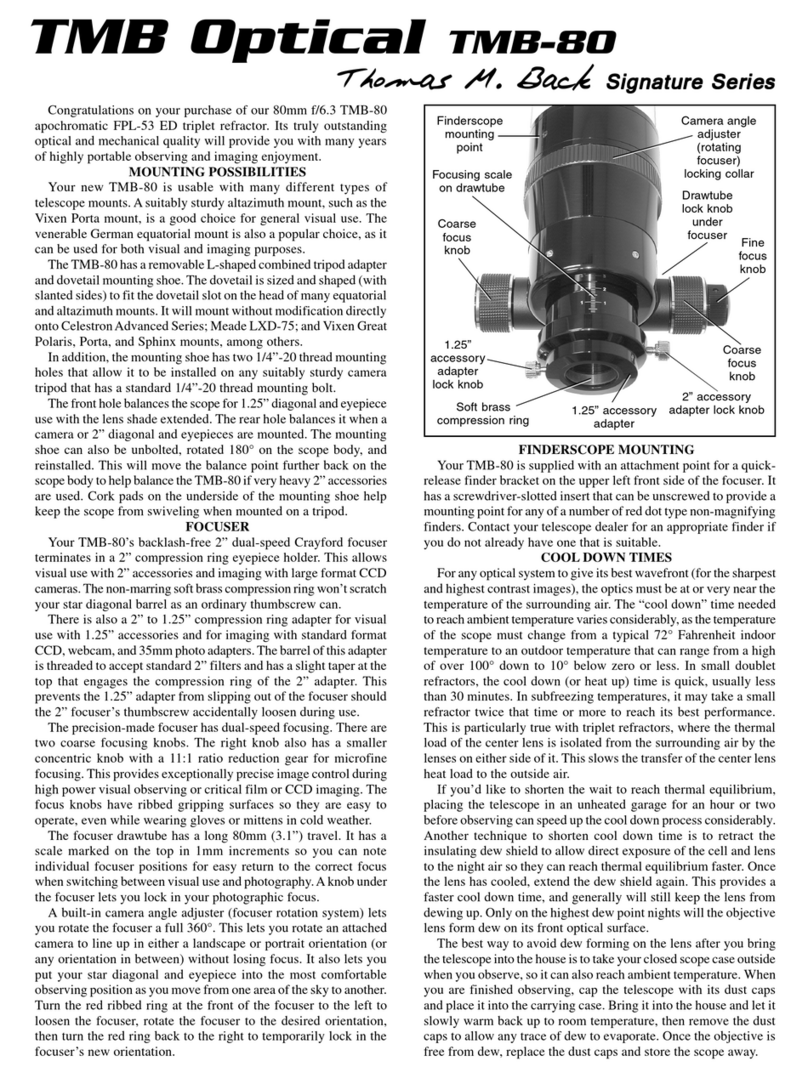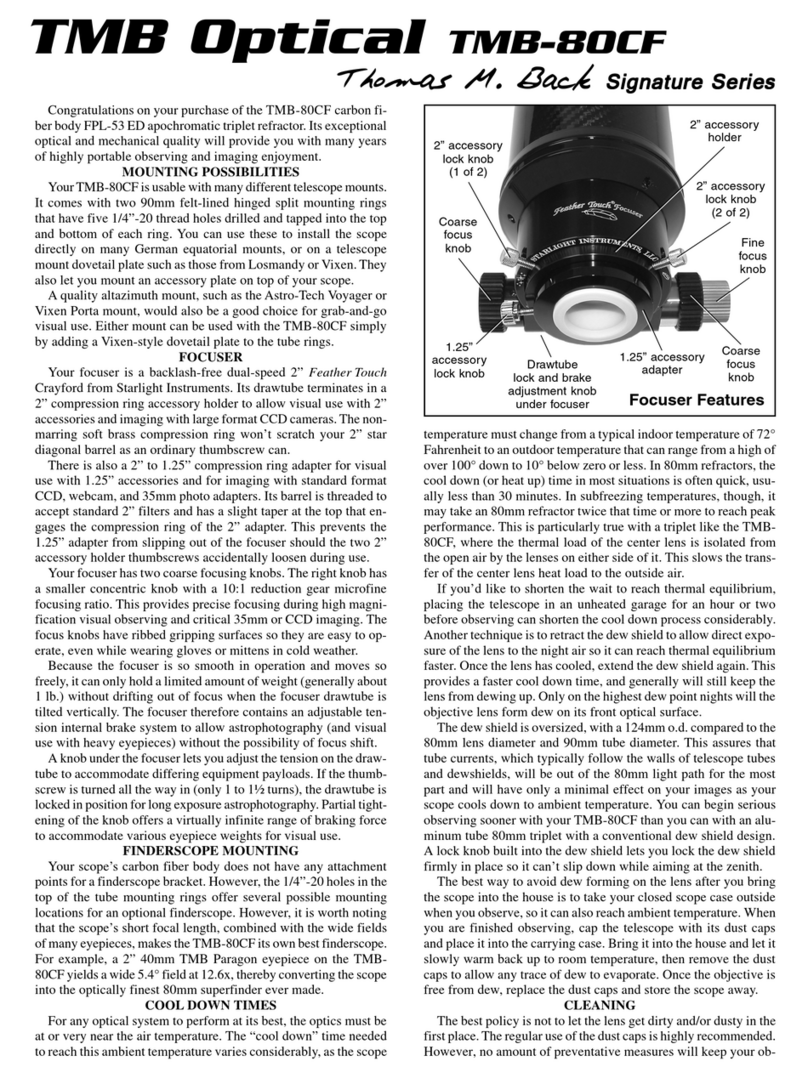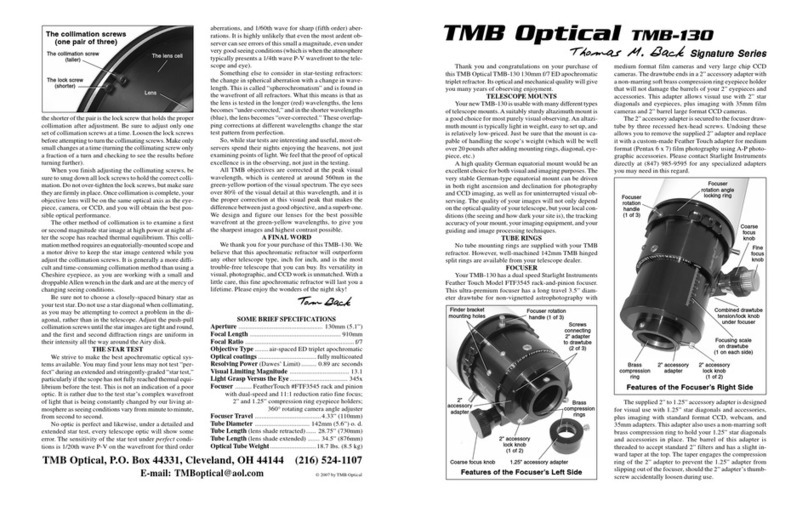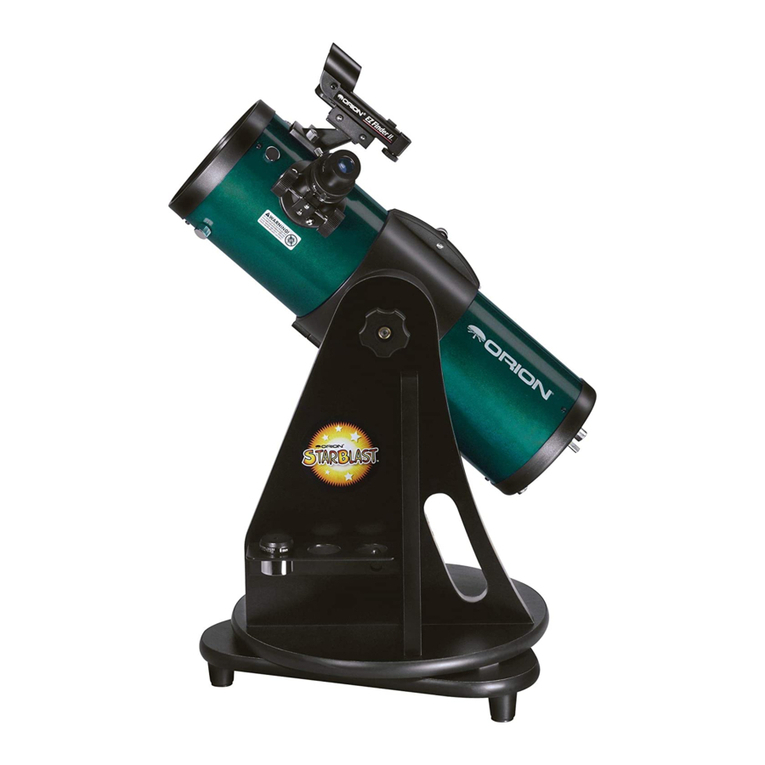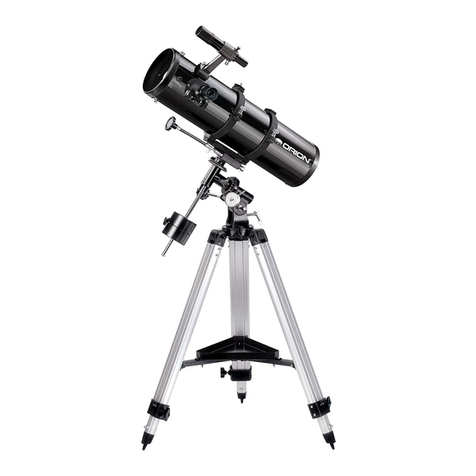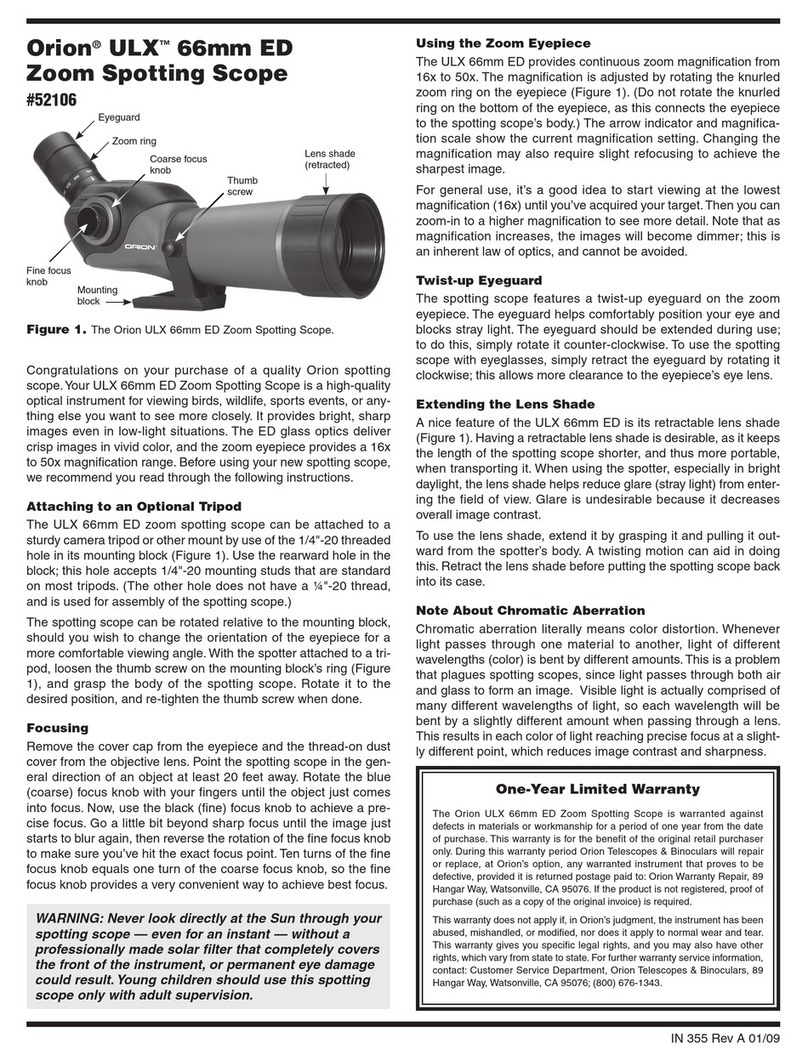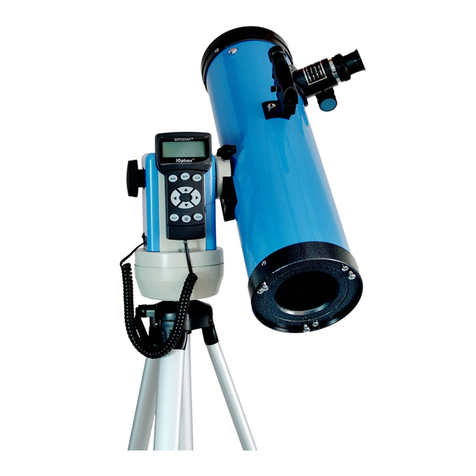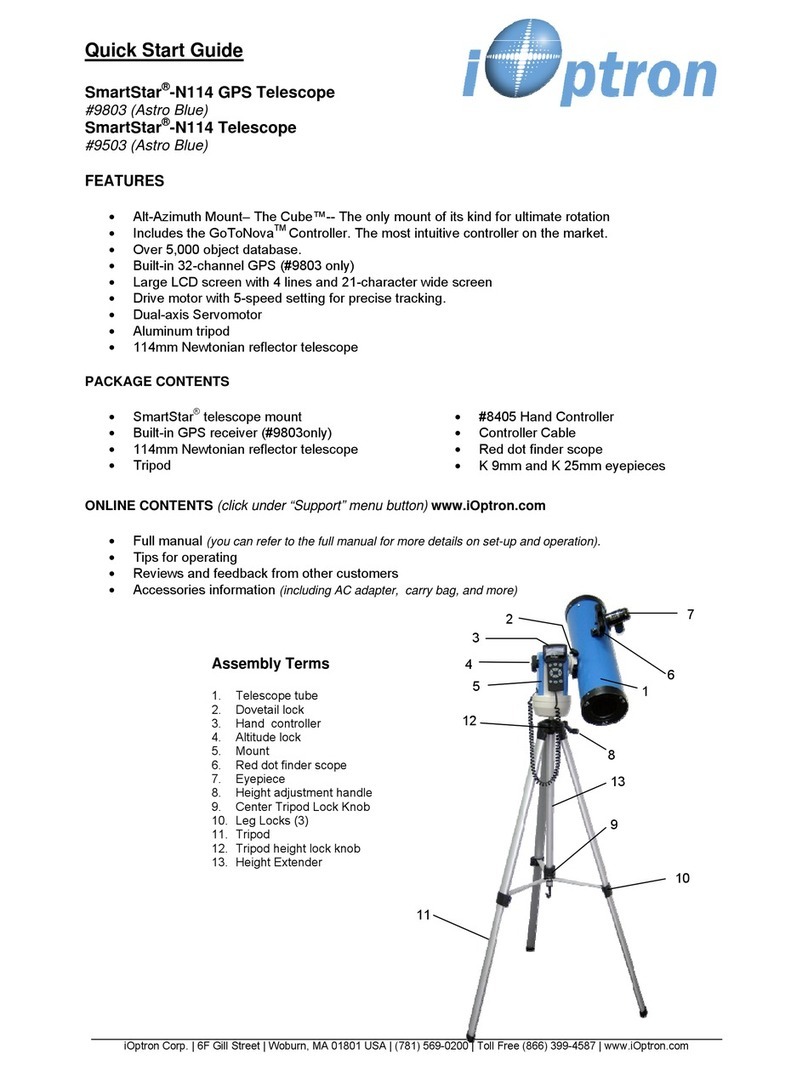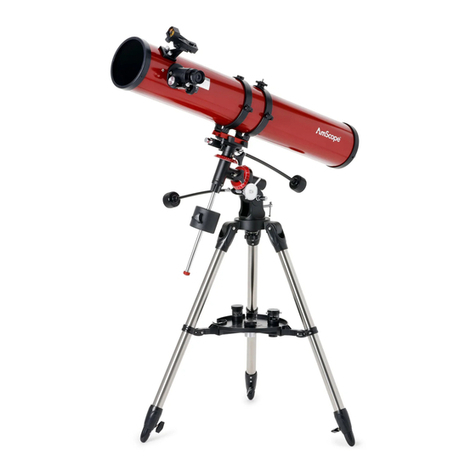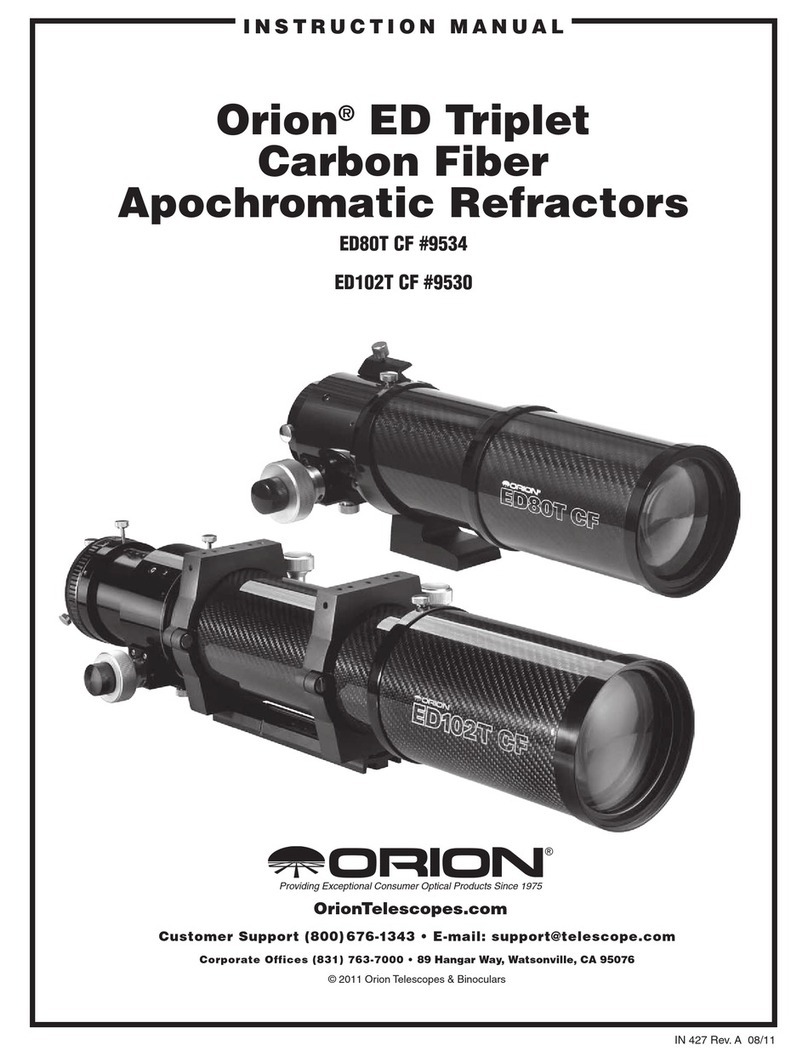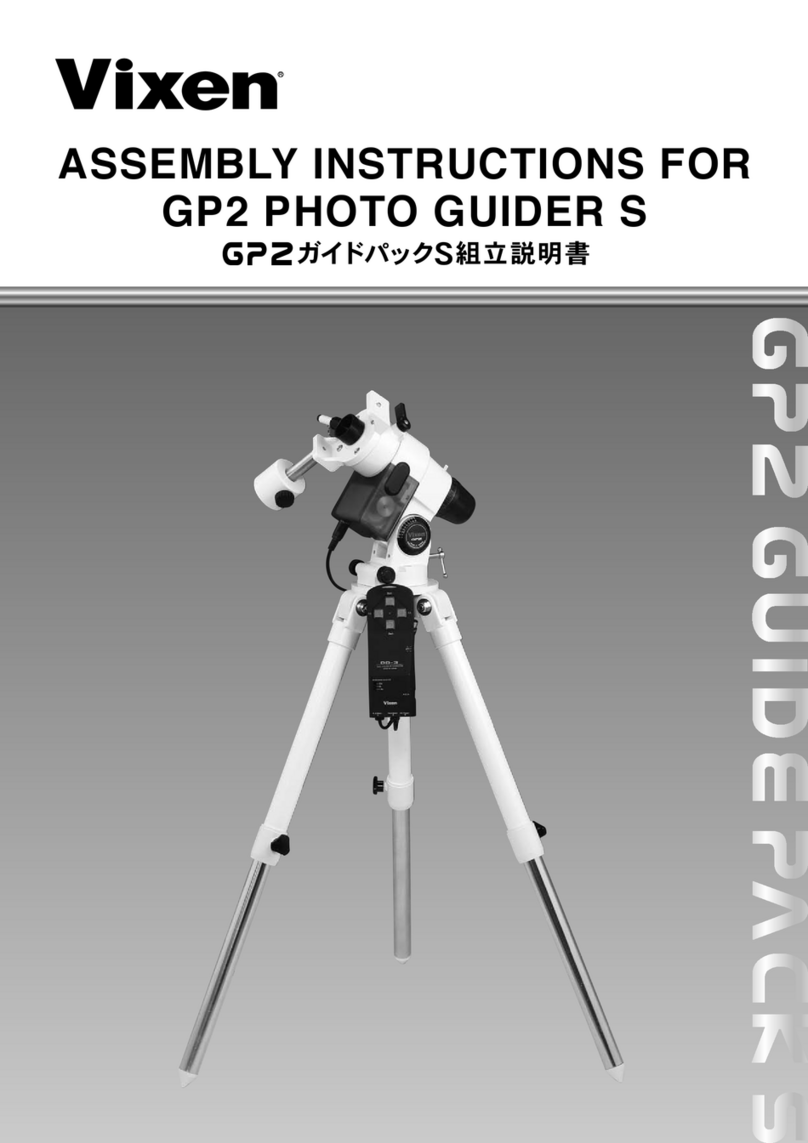TMB Optical TMB-92 User manual

Features of the Focuser’s Left Side
SignatureSignature
SignatureSignature
Signature SeriesSeries
SeriesSeries
Series
TMB Optical
TMB-92
Thoma
sM. Back
CongratulationsonyourpurchaseofthisTMBOpticalTMB-
92 Signature Series air-spaced apochromatic triplet refractor.
This exceptional 92mm f/5.5 scope uses an element of costly
FPL-53 ED (Extra-low Dispersion) glass to achieve true apo-
chromatic visual and photographic performance, free from chro-
matic aberration and spurious color.
At only 13.25” in length, the TMB-92 is a premium quality
ultra-compact refractor that we believe elegantly and more than
capably fills the void left by the long-discontinued 90mm Astro-
Physics Stowaway (a legendary refractor that sells for up to
$6000 on the used market).
The fully-collimatable TMB-92’s truly outstanding optical
and mechanical quality will provide you with many years of
highly portable visual observing and imaging enjoyment.
PHOTO/VISUALCONFIGURATIONS
The TMB-92 consists of an optical tube assembly with lens
and dew shield, a Feather Touch focuser that slips into the op-
tical tube and is locked firmly in place by three brass knobs that
allow 360° rotation of the focuser, and
a 2.25” extension tube that can be in-
stalled between the optical tube and the
focuser for visual use.
When the optical tube and focuser
are assembled without the extension
tube, the resulting physically short tele-
scope configuration provides the long
back focus needed by those primarily
interested in serious CCD imaging us-
ing long equipment trains: camera, filter wheel, adaptive optics
system, etc. This arrangement also allows binoviewer use with-
out the need for a Barlow or optical compensator lens.
For occasional visual work, a simple optional compression
ring extension tube (from Astro-Tech, TeleVue, and others) can
be slipped into the scope’s 2” accessory holder to provide the
necessary extra physical length to reach focus with a star di-
agonal and eyepiece.
For those primarily interested in visual observing and only
casual imaging with a 35mm camera, webcam, or Deep Sky
Imager-type CCD camera, a 2.25" extension tube (shown above)
is supplied to provide the proper back focus for comfortable
visual use and casual astrophotography. This extension installs
between the optical tube and focuser. Agroove in the extension
tube engages the large brass lock knobs in the optical tube (that
normally control focuser rotation) to lock the extension tube
firmly to the optical tube. Three nylon-tipped metal lock knobs
at the opposite end
of the extension tube
now lock the focuser
in place and allow
focuser rotation, just
as the large brass
lock knobs in the op-
tical tube do when
the extension tube is
not used. A Teflon
insert in the focuser
end of the extension
tube assures smooth
focuser rotation.
The supplied carrying case is precut to hold the TMB-92 in
either short body imaging or long body visual configurations.
FOCUSER
Your TMB-92 features an ultra-precision Feather Touch
Model 3025 dual-speed rack-and-pinion focuser from Starlight
Instruments. This exceptionally smooth focuser has a 3” diam-
eter drawtube for non-vignetted astrophotography with medium
format film cameras and very large chip CCD cameras. The
drawtube ends in a 2” accessory adapter with a non-marring
compression ring eyepiece/accessory holder that will not dam-
age the barrels of your 2” accessories. Three hand-tighten lock
knobs on the adapter assure the compression ring’s solid grip
on heavy accessory loads. This adapter allows visual use with
2” star diagonals, plus imaging with 35mm film cameras and
2” barrel large format CCD cameras.
The 2” accessory adapter is secured to the focuser drawtube
by three recessed hex-head screws. Undoing these allows you
to remove the supplied 2” adapter and replace it with a custom-
made Feather Touch adapter for medium format (Pentax 6 x 7)
film photography using A-P photographic accessories. Please
contact Starlight Instruments directly at (847) 985-9595 for any
specialized adapters you may need in this regard.
The supplied 2” to 1.25” accessory adapter is designed for
visual use with 1.25” star diagonals, plus imaging with stan-
dard 1.25” format CCD, webcam, and 35mm adapters. This
Left coarse
focus knob
Focuser rotation/extension tube
lock knob (1 of 3)
2”
accessory
adapter
1.25” accessory adapter
Compression
ring
Retracted
lens shade
Compression
ring 1.25”
accessory
lock knob
2” accessory
lock knob
(1 of 3)
2.25” visual extension
tube installs here
Hex head
screw
attaching 2”
adapter to
drawtube
(2 of 3)
Supplied
Extension Tube
Extension Tube Installed
Extension
tube
Original focuser
rotation lock knob
(1 of 3)
New
focuser
rotation
lock knob
(1 of 3)
© 2008 by TMB Optical
camel’s hair brush with attached blower bulb, for example).
The use of canned or compressed air should be avoided, if pos-
sible, as the propellant in the can may spit out and leave diffi-
cult-to-remove deposits on your lens.Also, the expanding com-
pressed air drops in temperature as it leaves the can. The cold
air coming out of the tiny tube that most compressed air cans
use to direct the air flow has been known to chill a lens to the
point of spalling chips off the lens if pointed at the same spot
on the glass for too long.
If you want, or need, to use compressed air to remove stub-
born particles, use a high quality compressed air duster (of the
R-134 propellant type). ChemTronics sells a high-quality unit.
Do not tip or shake the can. Blow any loose particles off the
lens surface using short blasts at an angle to the glass, without
getting too close to the lens surface or aiming directly at it.
Next, moisten a ball of USP grade pure cotton with a few
drops of a photographic-quality optical cleaning solution de-
signed for multicoated camera and binocular lenses. You can
use Formula MC (available from many telescope dealers) or
your own mixture of distilled water and a drop or two of mild
soap. A well-worn 100% cotton handkerchief also works well
and Zeiss and Kodak both make suitable cleaning fluids. Blot
the entire surface with the dampened cotton ball or cloth to
pick up any stubborn particles and to clean the surface. Ex-
change the cotton ball and/or turn the cloth frequently so you
always have a clean portion of the cotton ball or cloth in con-
tact with the lens.
Use a very small amount of liquid – not so much that the
fluid could be wicked between the lenses by capillary action.
Do not drip the cleaning fluid directly on the lens. Do not, at
any stage, apply hard pressure. Using a fresh piece of cotton or
a lint-free white facial tissue, carefully clean the surface of the
lens by wiping across in a radial direction. Repeat the process
with denatured alcohol, using a blower brush to clean off any
dust that may fall on the lens as you are cleaning it.
If you want to take the ultimate step in cleaning, a final rinse
with high-grade acetone will clean the surface to new condi-
tion. You may notice a few faint streaks from the dried solvent.
They will not affect performance, but they can be removed with
light pressure and a Q-Tip slightly moistened with a small
amount of alcohol or acetone. Finally, a clean air blower bulb
can be used to remove any remaining dust.
Avoid overcleaning your scope. The multicoatings on the lens
are quite hard and durable. However, frequent overzealous
cleaning can scratch the coatings if all the dust particles (which
are often tiny flecks of windborne rock) are not removed be-
fore you start pushing a damp tissue around the lens surface.
Clean your optics only when absolutely necessary. If you take
proper care of your TMB-92, cleaning should rarely be needed.
THE STAR TEST
We strive to make the best apochromatic optical systems avail-
able. You may find your lens may not test “perfect” during an
extended and stringently-graded “star test,” particularly if the
scope has not fully reached thermal equilibrium before the test.
This is not an indication of a poor optic, but is rather due to the
test star’s complex wavefront continually changing as the see-
ing conditions in our living atmosphere vary from moment to
moment.
No optic is perfect, and every brand and model scope will
show some error in an extended star test. The sensitivity of the
star test under perfect conditions is 1/20th wave P-V on the
wavefront for third order aberrations, and 1/60th wave for sharp
(fifth order) aberrations. It is highly unlikely that even the most
ardent observer can see errors of this small a magnitude on an
extended object, even under very good seeing conditions (which
is when the atmosphere typically presents no better than a 1/4th
wave P-V wavefront to the instrument).
The refractor also presents another factor: the change in
spherical aberration with a change in wavelength. This “sphero-
chromatism” is found in all refractors.As a lens is tested in the
longer (red) wavelengths, the lens becomes “under-corrected.”
Tested in the shorter wavelengths (blue), the lens becomes “over-
corrected.” These overlapping corrections at different wave-
lengths change the star test pattern from technical perfection.
However, TMB objectives are corrected at the peak visual
wavelength centered around 560nm in the green-yellow por-
tion of the visual spectrum. The eye sees over 80% of the vi-
sual detail at this wavelength. It is the correction at this visual
peak that makes the difference between a merely good objec-
tive and a superb one. Our lenses are figured for the best pos-
sible wavefront at green-yellow wavelengths, for the sharpest
images and highest contrast.
While star tests are interesting and useful, they should not be
the only criterion for judging any telescope’s quality. Most ob-
servers spend their nights enjoying the views of extended and
detailedobjects–likenebulae,galaxies,starclusters,andplanets
– not simply examining a star test’s single out-of-focus point
of light. We feel that the true proof of optical excellence will be
found in your nightly observing, not just in star testing.
A FINAL WORD
Thank you for your purchase of our TMB-92. We believe
that this ultra-compact apochromatic refractor will outperform
any other telescope type, inch for inch, and is the most trouble-
and maintenance-free telescope that you can buy. Its versatility
for visual, photographic, and CCD work is unmatched. With a
little care, this fine apochromatic refractor will last you a life-
time. Use it to enjoy the wonders of the night sky!
BRIEF SPECIFICATIONS
Aperture ............................................................. 92mm (3.6”)
Focal Length ...............................................................506mm
Focal Ratio ...................................................................... f/5.5
Objective Type ......................air-spaced apochromatic triplet
with an FPL-53 ED glass element
Optical coatings .......................................... fully multicoated
Resolving Power (Dawes’ Limit) ................. 1.26 arc seconds
Visual Limiting Magnitude.............................................12.3
Light Grasp Versus the Eye ...........................................173x
Focuser............... Starlight Instruments Feather Touch #3025
3” dual speed rack and pinion, with 10:1 ratio fine focus;
2” and 1.25” compression ring eyepiece holders;
and 360° rotating camera angle adjuster
Focuser Travel.................................................. 2.56” (65mm)
Tube Diameter.......................................... 114mm (4.5”) o. d.
Minimum tube Length ................................ 13.25” (337mm)
(set up for imaging, lens shade and focuser retracted)
Tube Length ...................................................... 16” (406mm)
(set up for imaging, lens shade extended, focuser retracted)
Maximum Tube Length............................... 20.75” (522mm)
(set up for visual use, lens shade and focuser extended)
Optical Tube Weight................................... 8.5 lbs. (3.86 kg)
Case Dimensions ................................... 22.25” x 12.75” x 8”

adapter also uses a non-marring compression ring to hold your
1.25” star diagonals and accessories in place. The barrel of this
adapter is threaded to accept standard 2” filters and has a slight
inward taper at the top. The taper engages the compression ring
of the 2” adapter to prevent the 1.25” adapter from slipping out
of the focuser, should the 2” adapter’s thumbscrew acciden-
tally loosen during use.
Your Feather Touch focuser has dual-speed focusing. There
are two coarse focusing knobs. The right knob also has a smaller
concentric knob with a 10:1 ratio reduction gear for microfine
focusing. This provides exceptionally precise image control
during high power visual observing and critical film or CCD
imaging. The large focus knobs have ribbed gripping surfaces
so they are easy to operate, even while wearing gloves or mit-
tens in cold weather.
Your focuser drawtube has a 65mm (2.56”) travel. It has two
scales (one on either side) that are laser-engraved in 1mm in-
crements. These let you note individual focuser positions for
easy return to the correct focus when switching between visual
use and photography.
Because your Feather Touch focuser is so smooth in opera-
tion and moves so freely, it can only hold a limited amount of
weight (generally about 1 lb.) without drifting out of focus when
the focuser drawtube is not horizontal and has a significant
vertical component. The focuser therefore contains an adjust-
able-tension internal brake system to allow astrophotography
and visual use with heavy eyepieces without the possibility of
focus shift.
The brake consists of a lever arrangement within the focuser’s
pinion block. Adjusting the thumbscrew underneath the pinion
block causes the lever to press a friction pad onto the pinion.
This increases the torque needed to turn the focus knobs. If the
thumbscrew is turned all the way in (only 1 to 1½ turns), the
pinion shaft and drawtube are essentially locked into position.
Partial tightening of the internal brake offers a virtually infinite
range of braking force to accommodate various eyepiece and
accessory weights.
A separate large hand-tighten drawtube lock knob on the top
of the focuser body locks the drawtube securely in place at any
desired focus point.
A built-in camera angle adjuster (focuser rotation system)
lets you rotate the focuser a full 360° without losing focus.
This lets you rotate the focuser to line up a camera in either a
landscape or portrait orientation (or any orientation in between).
It also lets you put your star diagonal and eyepiece in the most
comfortable observing position as you move from one area of
the sky to another.
Three hand-tighten focuser rotation lock knobs around the
front of the focuser body let you adjust the focuser rotation
angle. Loosen the lock knobs by turning them counterclock-
wise to unlock the focuser. Rotate the focuser to the desired
new orientation. Turn all three lock knobs clockwise to lock
the focuser firmly in place at the new angle.
Your focuser drawtube glides on three stainless steel straps
that mate with Teflon bearing surfaces to provide very tight yet
extremely smooth motion. This design eliminates the need for
grease between the housing and drawtube. A greaseless draw-
tube prevents the collection of dirt that may eventually cause
problems between these surfaces, so no routine focuser main-
tenance is required except for an occasional wipe down of the
drawtube with a soft cloth.
TUBE RINGS
No tube mounting rings are supplied with your TMB refrac-
tor. However, precision-machined 114mm TMB hinged split
rings are available from your telescope dealer.
FINDERSCOPE MOUNTING
No finderscope is provided with your TMB-92. However,
there are two holes for a finder bracket drilled and tapped on
1.25” centers at the 2 o’clock position on the focuser body.
These holes will accept any of a number of finderscope mount-
ing rings. Contact your telescope dealer for an appropriate finder
if you do not already have one that is suitable.
COOLDOWN TIMES
Foranyopticalsystemto give its best wavefront (for the sharp-
est and highest contrast images), the optics must be at or very
near the temperature of the surrounding air. The “cool down”
time needed to reach ambient temperature varies considerably,
as the temperature of the scope must change from a typical 72°
Fahrenheit indoor temperature to an outdoor temperature that
can range from a high of over 100° down to 10° below zero or
less. In small doublet refractors, the cool down (or heat up)
time is quick, usually less than 30 minutes. In subfreezing tem-
peratures, it may take a small refractor twice that time or more
to reach its best performance. This is particularly true with trip-
let refractors, such as your TMB-92, where the thermal load of
the center lens is isolated from the surrounding air by the lenses
on either side of it. This slows the transfer of the center lens
heat load to the outside air.
If you’d like to shorten the wait to reach thermal equilib-
rium, placing the telescope in an unheated garage for an hour
or two before observing can speed up the cool down process
considerably. Another technique to shorten the cool down time
is to retract the insulating dew shield to allow direct exposure
of the cell and lens to the night air so they can reach thermal
equilibrium faster. Once the lens has cooled, extend the dew
shield again. This provides a faster cool down time, and gener-
ally will still keep the lens from dewing up. Only on the highest
Features of the Focuser’s Right Side
Right
coarse
focus
knob
Fine
focus
knob
Focusing scale
on drawtube
(1 on each side)
Combined brake/drawtube
tension knob under focuser
Screws sealing the
mounting holes for an
optional finder bracket
Focuser rotation
lock knob (1 of 3)
Retracted
lens shade
2” accessory
lock knob
(1 of 3)
Drawtube
lock knob
Focuser
unthreads here to
install 2” visual
extension tube
center circles to form a single round circle. The illustration be-
low shows a close-up of one of the collimation screw pairs.
The taller screw is the actual collimation screw, while the
shorter of the pair is the lock screw that holds the proper colli-
mation after adjustment. Be sure to adjust only one set of colli-
mation screws at a time. Loosen the lock screws before attempt-
ing to turn the collimating screws. Make only small changes at
a time (turning the collimating screw only a fraction of a turn
and checking to see the results before turning further).
When you finish adjusting the collimating screws, be sure to
snug down all lock screws to hold the correct collimation. Do
not over-tighten the lock screws, but make sure they are firmly
in place. Once collimation is complete, your objective lens will
be on the same optical axis as the eyepiece, camera, or CCD,
and you will obtain the best possible optical performance.
The other method of collimation is to examine a first or sec-
ond magnitude star image at high power at night after the scope
has reached thermal equilibrium. This collimation method re-
quires an equatorially-mounted scope and a motor drive to keep
the star image centered while you adjust the collimation screws.
It is generally a more difficult and time-consuming collimation
method than using a Cheshire eyepiece, as you are working
with a small and droppable Allen wrench in the dark and are at
the mercy of changing seeing conditions.
Be sure not to choose a closely-spaced binary star as your
test star. Do not use a star diagonal when collimating, as you
may be attempting to correct a problem in the diagonal, rather
than in the telescope. Adjust the push-pull collimation screws
until the star images are tight and round, and the first and sec-
ond diffraction rings are uniform in their intensity all the way
around the Airy disk.
CLEANING
The best policy is not to let the lens get dirty and/or dusty in
the first place. The regular use of the dust caps is highly recom-
mended. However, no amount of preventative measures will
keep your objective from eventually collecting dust and air-
borne pollutants on the first optical surface. We recommend
that you do not clean the objective too often, no matter how
frequently the urge to do so may hit you. Afew specks of dust
on the lens will not be visible in your images, as they are not in
the focal plane and don’t block enough light to measure, let
alone be seen.
Depending on how often you use your scope, and the amount
of pollutants in your air, you may have to clean your scope as
often as twice a year, but generally no more than that – and
preferably no more than once a year. If the front lens surface
becomes dusty, smeared, or shows fingerprints or any other
surface build-up, and you find it absolutely necessary to clean
the lens, use the following cleaning technique.
First, gently blow away any surface dust or particles with a
clean air blower (a child’s ear syringe or a photographer’s
dew point nights will the objective lens form dew on its front
optical surface.
The best way to avoid dew forming on the lens after you
bring the telescope into the house is to take your scope case
outside when you observe, so it can also reach ambient tem-
perature. When you are finished observing, cap the telescope
with its dust caps and place it into the carrying case. Bring it
into the house and let it slowly warm back up to room tempera-
ture, then remove the dust caps to allow any trace of dew to
evaporate. Once the objective is free from dew, replace the dust
caps and store the scope away.
COLLIMATION
Your telescope was carefully collimated prior to shipment to
your dealer. With normal care the optics will keep that align-
ment permanently. However, if the telescope takes a very strong
blow in shipping or while transporting it to your observing site,
there is the small possibility that you may have to recollimate
the lens. The lens cell has three pairs of push-pull collimating
screws that will allow you to collimate it using a metric Allen
wrench.
To gain access to the collimation screws, remove the black
trim ring/knife-edge baffle from the front of the dew shield by
unthreading it in a counter-clockwise direction. Set it aside and
push the dew shield back on the optical tube until the front of
the dew shield clears the lens cell and exposes the collimation
screws in the flange at the rear of the lens cell, as shown in the
illustration below.
We recommend either of two collimation methods. In the first,
a “Cheshire” eyepiece (available from Tectron or your telescope
dealer) is inserted directly into the eyepiece holder (without
using a star diagonal). The Cheshire method can be used in-
doors or in the field, day or night.
The dust cover is placed over the lens cell to seal the objec-
tive end of the scope and keep light from entering the optical
tube.A bright light source is aimed at the opening in the side of
the Cheshire eyepiece. You can use the light from the sky out-
doors during the day. At night or indoors, aim the light of a
flashlight directly at the opening in the side of the Cheshire.
Look through the hole in the end of the Cheshire. You will
see a series of faint circles of reflected light against a black
background. If the circles of light are all concentric, your scope
is in collimation. If the circles of light are not concentric, ad-
just the push-pull collimation screws until you line up the off-
The collimation screws
(one pair of three)
The collimation screw
(taller)
The lock screw
(shorter)
The lens cell
Lens
Dew shield
fully
retracted
Collimation screws
(1 pair of 3)
Lens cell
Tr im ring /knife
edge baffle
removed from
dew shield
How to access the
collimation screws
Other TMB Optical Telescope manuals
Popular Telescope manuals by other brands
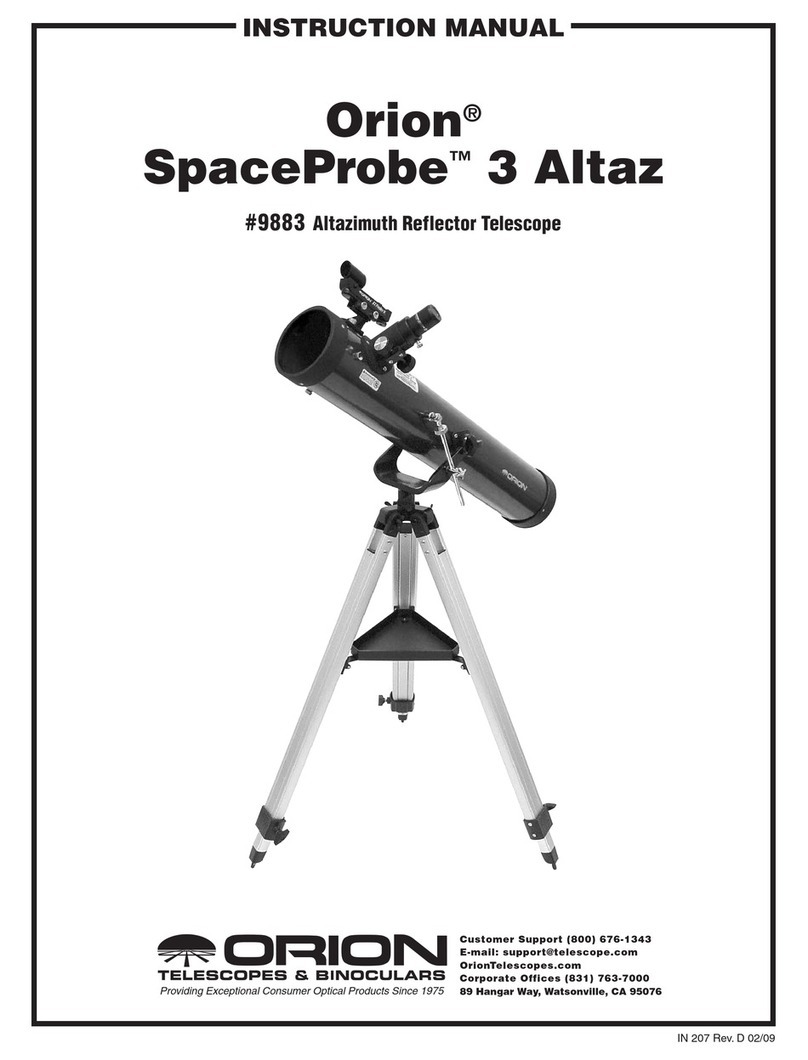
ORION TELESCOPES & BINOCULARS
ORION TELESCOPES & BINOCULARS SpaceProbe 3 Altaz 9883 instruction manual
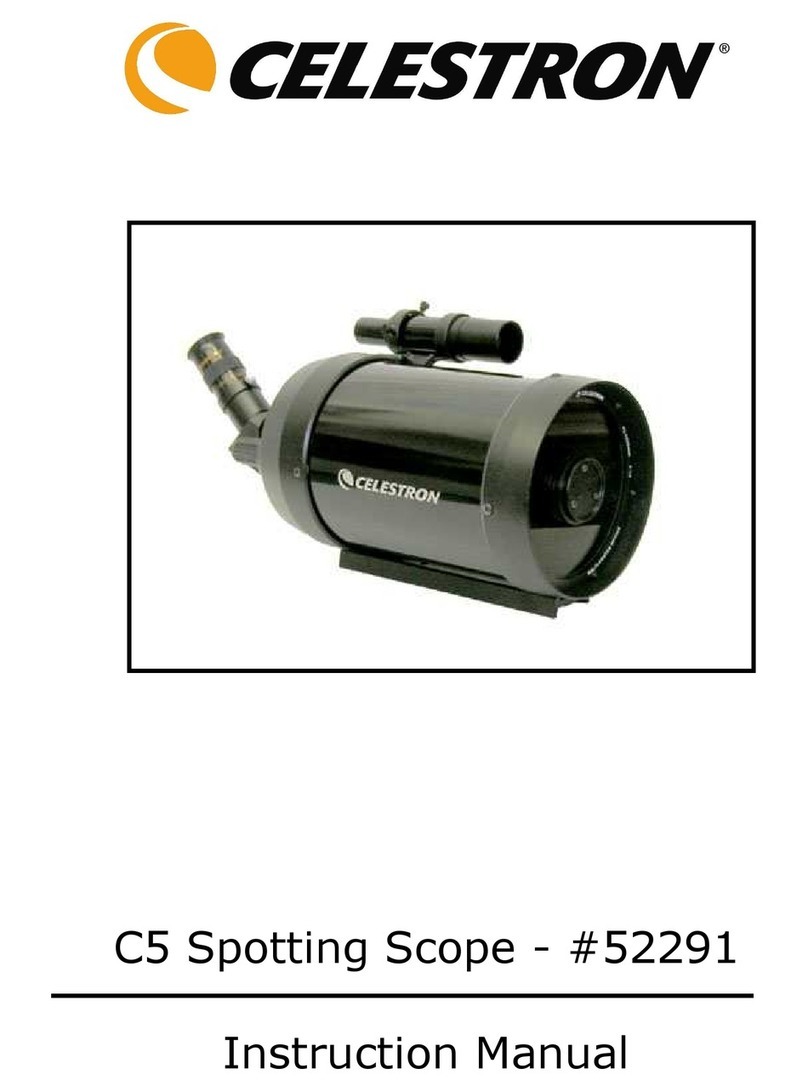
Celestron
Celestron 52291 instruction manual
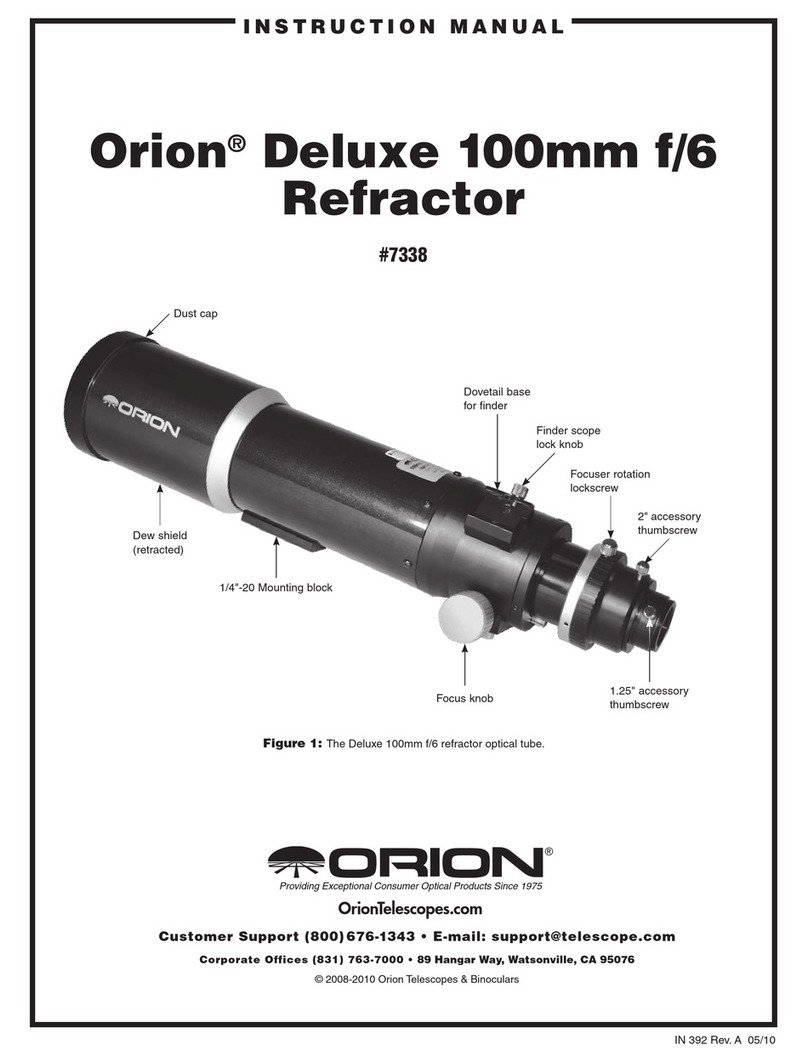
Orion
Orion 7338 manual
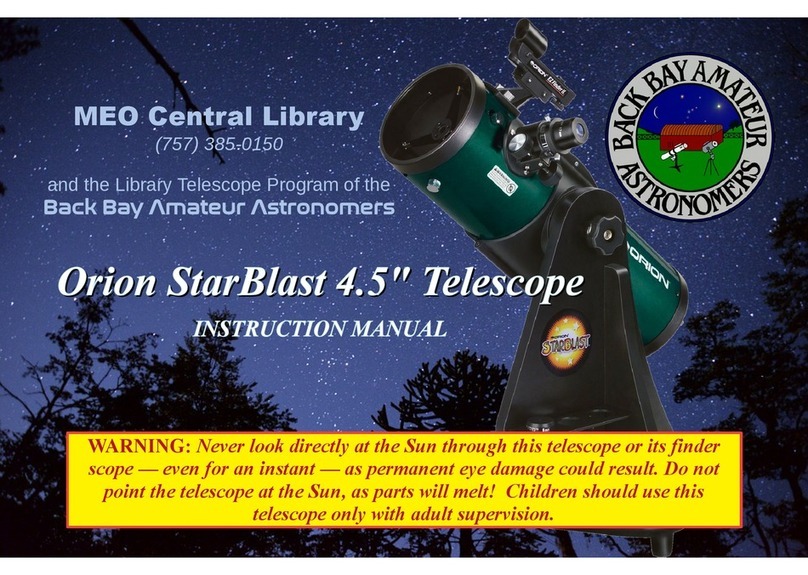
Orion
Orion StarBlast 4.5 instruction manual
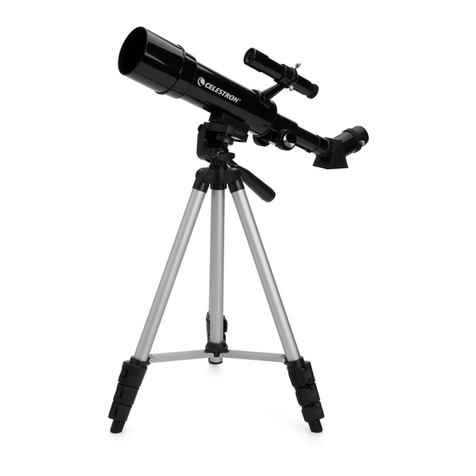
Celestron
Celestron Travel Scope 50 instruction manual
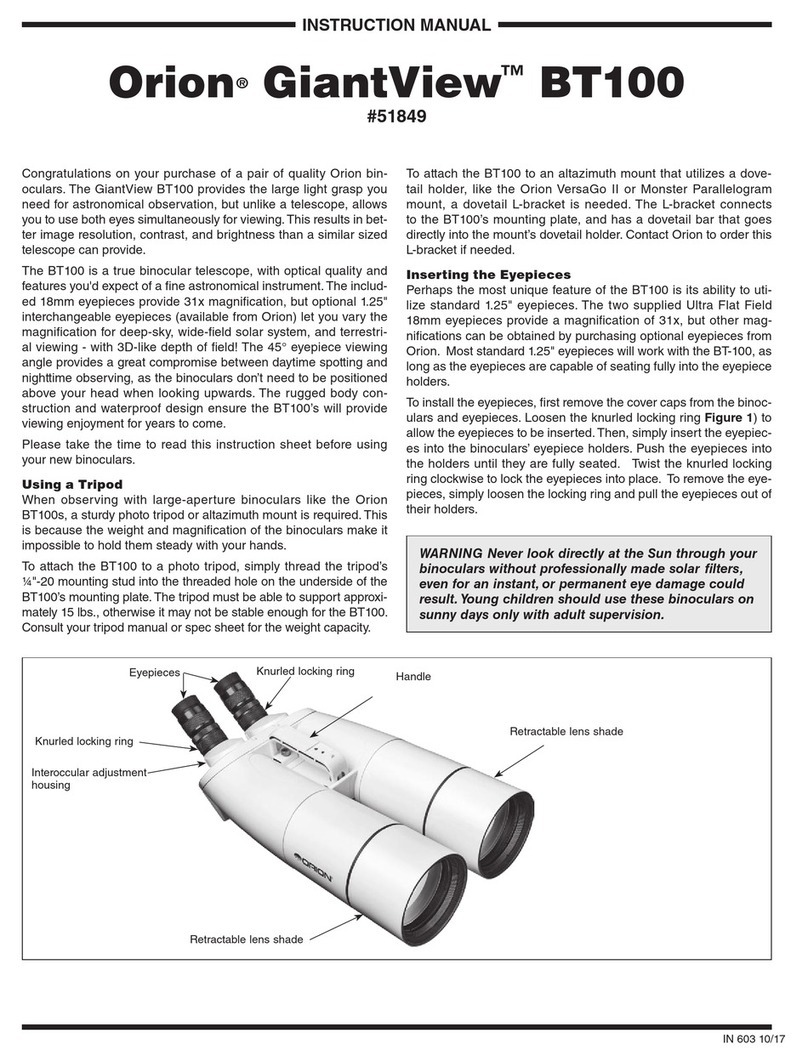
Orion
Orion GiantView BT100 instruction manual
